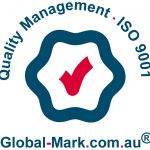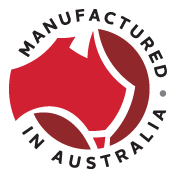Strong hoof health is essential for keeping a consistent feed intake while reducing injury prevalence and economic loss, which is why the Garvan Park Feedlot (GPF) team have included quality, specific organic trace mineral, ZinMet®, in their backgrounding process.
With increased wet weather inundating Victorian farmlands and waterlogging pastures, GPF Feedlot Manager Nic Cook noticed more cattle were coming in from the sale yard with sore feet.
Nic says he believes prolonged exposure to waterlogged land was softening the cattle’s hooves before going to the sale yards, where standing and walking on hard surfaces was leading to sore feet for the stock.
“When hooves are wet for extended periods, it can soften the tissue making bruising and penetration injuries more common,” he says.

Operating since 2004, Garvan Park Feedlot is capable of running 3500 head of cattle where they feed mixed breeds of cattle.
The GPF team include ZinMet® in their feedlot feed but also in their supplemental feed for backgrounding cattle to get them ready for intensive feeding.
“When cattle have sore feet, they’re less likely to travel through the paddock to access supplemental feed which, in turn, affects their performance and means they start their intensive feeding at a lower weight,” Nic says.
“Including ZinMet® into their feed, we started noticing an improvement in the hoof health of affected cattle within a couple of weeks, walking more confidently.”
Nic Cook, Garvan Park Feedlot

A combined source of specific organic trace minerals, zinc and chromium, ZinMet® stimulates keratin (the protein that helps form hooves) production in treated animals, accelerating hoof growth, hoof hardening, and maintaining cellular integrity.
Nic says GPF has been using ZinMet® for about four years, and when the weather is particularly wet and on the suggestion from their nutritionist, they double the dosage to ensure the stock are getting what they need.
Austasia Animal Products National Sales Manager Paul Lloyd says ZinMet®’s unique complexation of zinc and chromium boosts the performance of feedlot cattle by improving their cell sensitivity to insulin.
“Insulin plays a critical role in many of the physiological functions in beef cattle and chromium is the essential trace element that makes it happen,” he said.
“Recent research has found ZinMet® enhanced feedlot cattle performance with a 3% increase in average daily gains and a 2.3% improvement in dry matter feed conversion.
“This combination of minerals is bound to a specific organic escort, methionine, which helps bypass rumen degradation at approximately 80%, making ZinMet® more readily available for absorption through the gastrointestinal tract.”

Proudly manufactured in AAP’s state-of-the-art facility at Forbes, NSW, ZinMet® is the only specific-organic trace mineral additive in the domestic market made in Australia.
Nic said his experience working with AAP had been positive, appreciating the professional and personal services they provide.
“Our AAP Sales Manager Liam drops in to see how we’re going, and since working with him, he has taken the time to get to know our operation and what we’re trying to achieve,” he says.
“If there are cattle producers, feedlots or farmers looking to improve the hoof health of their cattle, I recommend introducing ZinMet® or working with Austasia Animal Products.”
Learn more about our quality-specific organic trace mineral, ZinMet®, and its benefits for feedlot cattle.
Please be aware this article contains graphic images of a severely injured horse’s leg. Discretion is advised.
Healesville Horse Owner Alison Callaghan’s stomach sank after a severe injury had degloved her horse, Abbiey’s leg, leading to an expected six-to-eight-month recovery which Alison believes has been accelerated with the inclusion of ZinMet® 50.
Alison believes Abbiey may have gotten her leg caught in a gnarled branch that had perforated her skin, leading to her degloving the soft tissue of her leg when she pulled it free.
“The injury was that severe, it had exposed the bone,” she said.
Abbiey's injury


Facing a lengthy recovery time, Alison said she and the Vet were surprised to see how quickly Abbiey’s wound was healing after inspecting the wound three days later.
“Taking the bandages off to look at Abbiey’s leg, we were both surprised to see how quickly the soft tissue began to recover,” she said.
Three days after Abbiey's injury



Alison’s first introduced ZinMet® 50 to her horses about four years ago from Victorian Stockist, Tracey Mallia who swears by the organic trace mineral additive.
Alison said she includes ZinMet® along with vitamin C and magnesium in Abbiey’s feed, giving her 14.4g twice daily.
“Being a 19-year-old Arabian, Abbiey was prone to rain scald and skin peeling on her nose before being introduced to the additive.
“When we ran out of ZinMet®, we noticed her healing had slowed down until we were restocked.”
10 weeks after Abbiey's injury.



ZinMet® contains vital trace minerals zinc and chromium that are bound to methionine which allows ~80% absorption through the gastrointestinal tract.
Austasia Animal Products National Business Manager Paul Lloyd said ZinMet® was ideal for equine animals experiencing prolonged wet weather, exposed hard/rough stalls, waterlogged soils, health challenges, or a high prevalence of lameness.
“This combination of organic trace minerals enhances wound recovery by boosting the generation of epithelial tissue such as the skin and hooves while also increasing the tolerance to, and recovery from stress and morbidity,” he said.
While Abbiey still has a bit of a recovery time ahead of her Alison said she believes Abbiey’s healing has been in conjunction with her use of ZinMet®.
Learn more about our quality-specific organic trace mineral, ZinMet®, and its benefits for equine animals.
Gut health is the cornerstone to boosting the gains and condition of your cattle, which is why Cadelga Cattle Company Directors Jason and Maureen Johnstone have included the market’s most extensively researched direct-fed microbial probiotic, Beef Culture, in their feeding program.
Jason and Maureen opened the gates to the Cadelga Cattle Company feedlot in the heart of the Darling Downs in 2018. Running about 5000 head of cattle, they feed a combination of British breeds for the domestic market and Black Angus on a longer-fed program for the export market.
Beginning their feeding operation, Jason and Maureen met with Austasia Animal Products where they were introduced to AAP’s signature specific organic trace mineral additives and premium probiotic products.
“At the time of opening Cadelga Cattle Company, Australia was in the groups of an intense drought,” Maureen said.
“The 2018 drought affected the majority of the Eastern Coast, with little rainfall making its way to the mainland which impacted the pasture quality for local farms. We had noticed the decline in the pasture quality had affected the condition of incoming cattle.
"Because the quality of pasture wasn't providing enough sustenance for the cattle coming in, we our own research for a product to help improve the gut health of our cattle which led us to Beef Culture."
Maureen Johnstone, Cadelga Cattle Company
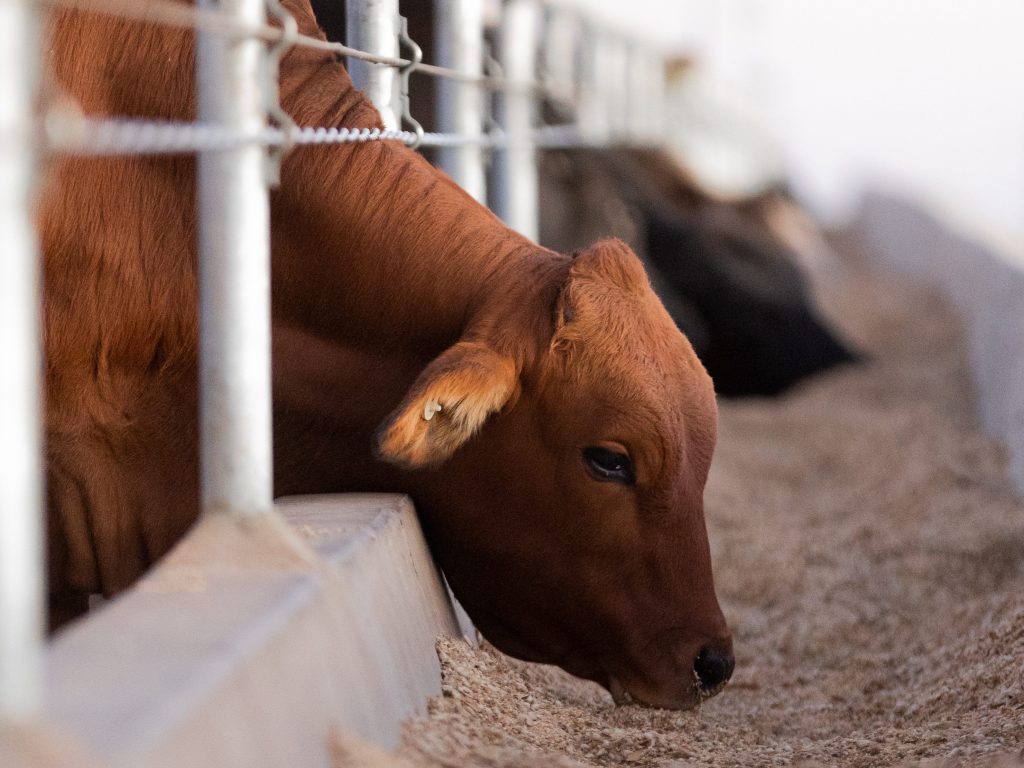
“AAP had the research and the data supporting positive benefits Beef Culture presents.”
Beef Culture is a direct-fed microbial that consists of Christian Hansen’s patented combination of Lactobacillus animallis and Propionibacterium freudenreichii, which is prepared at AAP’s state-of-the-art facility in Forbes, NSW.
This combination of lactic acid-producing and utilising bacteria enables changes to the gastrointestinal microflora, inhibiting the growth of gram-negative pathogens such as Salmonella, E coli., and Clostridia.
AAP National Business Manager Paul Lloyd said by inhibiting the growth of gram-negative pathogens in cattle, Beef Culture encourages the lengthening of intestinal villi which leads to an increased capacity for nutrient absorption.
“Improving the digestive system in feedlot cattle at the start of a feeding program sets up the foundation to better utilise their feed to improve their health performance,” he said.
“Enhancing the intestinal health of feeding cattle can remove the roadblocks to set your cattle up for success.”
After introducing Beef Culture into their feeding program, Jason and Maureen started to see positive changes in their cattle after about two weeks.
“The cattle that we introduced Beef Culture to were producing manure that was of a healthy consistency,” Maureen said.
“Working with AAP, they’ve taken the time to get to know not only our operation but also Jason and I with their excellent personable service. I recommend Austasia Animal Products, ZinMet, and Beef Culture to any lot feeders looking to enhance the performance of their operation.”
Learn more about the market’s most extensively researched probiotic additive, Beef Culture, and its benefits for beef cattle.
It’s been a busy year for our team travelling overseas and throughout the country, visiting customers, attending industry events, team members retiring and more.
Here is a summary of Austasia Animal Products 2023.
AAP Tours the USA


The start of this year saw Chris and Paul travel to North America to learn the latest news from our parent company Global Animal Products and the USA feedlot industry.
Chris and Paul attended the 2023 Cattle Industry Convention & NCBA Trade Show in New Orleans where they learnt about American feedlots and supporting industries.
After the conference, they travelled to Amarillo, Texas where they visited the Global Animal Product plant, gaining an insight into how their Texan counterparts operate and their plans for 2023.
The tour provided them with useful insights into American beef market developments, consumer trends, and emerging data on our products.
Fourth Annual Feeding Lambs for Profit Field Day


Our team made their way to Cowra to attend the Fourth Annual Feeding Lambs for Profit Field Day at the start of March.
The team had a great time catching up with customers and industry colleagues. With producers from all over Australia attending, there were several fantastic presentations from industry leaders such as Dr Stephen Bonner, Andrew Jackson from Thomas Food Industries, Dr Col Scrivener and more.
It was a great opportunity for our team to learn more about Australia’s lamb industry and get to know local producers.
Riverina BEEF4U

Committed to supporting all livestock industries across Australia, we were more than thrilled to support Riverina Stockfeeds’ BEEF4U as sponsors. Over the two days of the conference, Iain, John, and Liam caught up with customers, producers, and industry colleagues.
The second day of the conference was spent touring the award-winning Stockyard Beef Kerwee Feedlot at Jondaryan with additional presentations on agistment, cattle lung health, feed preparation, and more.
WagyuEdge 2023



At the start of April, the Team was in Sydney for the Wagyu sector’s largest conference, WagyuEdge 2023. The conference brings together the components of the sector under one roof.
WagyuEdge 2023 had industry experts hold in-depth presentations on production, exporting, nutrition, marketing and more.
Austasia unveils new look

Halfway through the year, we rebranded our logo to reflect our status as Australia’s market leader in specific organic trace minerals and probiotic additives.
The new branding is in line with our parent company Global Animal Products’s new branding while also being distinctly Austasia Animal Products.
Contact us to find the right specific organic trace mineral for you.
Christian Hansen launches new probiotic

As the sole providers of Christian Hansen’s Beef Culture, we were excited to see them launch the latest product Beef Culture Defend Plus at the National Cattleman’s Beef Association conference in New Orleans.
Beef Culture is a research-proven probiotic additive for feedlot cattle that contains two different species of Bacillus organisms which helps with weight gain in beef.
We can’t wait for Beef Culture Defend Plus to come to Australian markets.
Contact us to learn more about Beef Culture
AAP welcomes new CEO
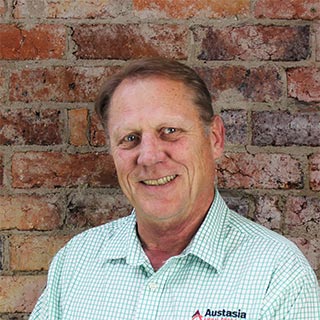
After more than 20 years leading our team, Chris decided it was time to take the step into a well-deserved retirement. We’re grateful for Chris’s service to AAP, using his skills and experience combined with his leadership to lead our team as the market leader of specific organic trace minerals and probiotic additives.
With his retirement, AAP appointed experienced agribusiness manager Gerhard Oberholzer as the new CEO. Gerhard brings over 20 years of experience in the agriculture industry working in both Australian and South Australian sectors.
We look forward to Gerhard leading our team, continuing where Chris had left off.
Beef, Bling, and Bowties

While we’re all working hard growing quality beef, it’s also important to let the hair down which is why we were proud to sponsor the Women of Lot Feeding’s Beef, Bling, and Bowties Ball.
The ball was a great excuse for Paul, Iain and Gerhard to look sharp, catch up with our customers, and have a good night out.
To keep up to date with our team, events, and news, follow Austasia Animal Products on social media.
Our Sales Team had the pleasure of attending the Australian Lot Feeders’ Association’s SmartBeef 2023 conference at Tamworth, NSW last month.
AAP CEO Gerhard along with Paul, Iain, Liam, Jason, and Tony from our team attended the two-day conference where they were able to catch up with our customers and colleagues while learning about the latest developments in the feedlot industry.

Throughout the conference, our team got an update about shade management from two of NSW’s prominent feedlot facilities from Andrew Talbot, Elders Killara Feedlot General Manager and Alex Smith, Rangers Valley Feedlot Manager.
Paul said AAP was proud to support SmartBeef 2023, sponsoring the SmartBeef Campdraft Competition.
“We have been proudly supporting Australian livestock industries since 1998, and sponsoring events such as SmartBeef 2023 is a great way to keep in touch with what is going on with our customers and the beef feedlot industry as a whole,” he said.

Some insights from SmartBeef 2023 included the benefits of investing in shelters to improve cattle performance.
“It was interesting to hear how feedlots are starting to utilise shelter to mitigate stress coming from the heat, rain and cold,” Paul said.
“Some operations are now investing in purpose-built shedding allowing them to harvest rainfall, or outfitting them with solar to power their feedlot. Building purpose-built infrastructure allows these operations to get more utility from their investment.”

ALFA President Barb Madden said the massive success of SmartBeef23 wouldn’t have been possible without the incredible support from our sponsors and Platinum Members.
“We thank everyone who came to the event. It was wonderful to host the largest crowd we have ever seen at a SmartBeef, it shows the strength in our industry,” she said.
Learn more about Australia's market leader in specific organic trace mineral and probiotic additives for local livestock industries.
Austasia Animal Products (AAP) has announced the appointment of experienced agribusiness manager Gerhard Oberholzer as its new CEO. Joining the AAP team on Monday, September 11, Gerhard picks up from where former CEO Chris O’Brien left off in retirement.

As CEO, Gerhard says his first six months in the role will be learning about AAP’s business, understanding their market, and getting to know their customers.
“AAP is committed to supplying safe, high-quality, and cost-effective products for all Australian livestock industries and it’s within this proven framework, I believe we will grow market share and broaden our product offering from our industry-leading manufacturing facility in Forbes, NSW,” Gerhard says.
Having worked with the company throughout his career, Gerhard says it’s a highly sought after opportunity to work with AAP’s qualified team and proven product as their CEO.
Working in the agriculture industry all his life, Gerhard’s experience in primary production and agribusiness spans over 35 years, in both Australian and South Africa industries.
With a Bachelor’s in Engineering, Masters in Business Administration, and a Masters in Project Management, Gerhard says he enjoys the challenge of value adding agricultural commodities and by-products, creating feed sources for our food, by applying scientific disciplines.
“Arriving in Australia in 2004, in pursuit of a better future for our children. Since moving to Australia, I continued with my career in agribusiness with oilseed processing, value adding commodities, before moving to stock feed manufacturing,” he says.
“My experience in Australia’s stock feed industry has prepared me to add value to AAP’s business through assessing and improving staff engagement, operational efficiencies, business systems and market growth.”
Gerhard says the Australian farming industry is facing a lot of demands from consumers, government, and other stakeholder groups.
“I believe our farmers are still the best people to address these demands that are being placed on the industry and we, as part of the feed industry, will work tirelessly to assist the farmer through scientifically developed solutions for animal welfare.”
Learn more about Australia’s market leader in specific organic trace minerals and probiotic additives for livestock industries.
An off-the-cuff chin wag about the benefits of including zinc in cattle feeding programs piqued farrier Ash Morris’ curiosity for Austasia Animal Products’ specific organic trace mineral, ZinMet.
Between running his own Shorthorn stud and hoof trimming business, Ash has seen first-hand the impact poor hoof health can have on the wellbeing of cattle.
Ash works with dairy and beef cattle operations throughout New South Wales and Queensland with his own business, Morris Hoof Trimming, providing quality maintenance and care.

“When servicing dairy cattle, we work hard to keep their hooves in the best condition to avoid the impact lameness and involuntary culling can have on production,” he says.
“I first learnt about ZinMet after a conversation with a mate who was working at Austasia Animal Products at the time, and I thought I would check it out for myself.”
After implementing ZinMet, Ash noticed small improvements to the overall wellbeing of the animals being treated with the specific organic trace mineral.
“The most notable changes I’ve seen in the animals treated with ZinMet would be the improvements to the skin and hair of our own cattle,” he says.
“One of my clients in Central Queensland also uses ZinMet in their feeding program, and they’ve noticed a change for the better in the hoof integrity and overall growth of their cattle.”
ZinMet is a combined source of specific organic trace minerals - zinc and chromium bound to methionine. The unique complexation of minerals to a specific organic escort bypasses rumen degradation at a rate of approximately 80 per cent, making ZinMet more readily available for absorption through the gastrointestinal tract.
"Research has shown ZinMet to reduce incidences of lameness by up to 43%."
AAP National Business Manager Paul Lloyd
“ZinMet helps reduce lameness in treated animals and also boosts their immune health, which results in improved wound healing, increased epithelial tissue repair, accelerated hoof growth, hoof hardening, and enhanced cellular integrity,” Paul says.

After seeing the improvements in his own herd, Ash now recommends ZinMet to his own clients, many of whom now use it in their own operations, plus quite a lot of feed companies that supply his customers also use ZinMet in their rations.
Ash says there’s a noticeable difference in the condition of cattle treated with ZinMet, with their skin being shinier and their feet being visibly healthier in general.
“The most notable results I have seen have been in bulls. Bulls treated with ZinMet could have stronger and healthier hooves in beasts as young as 14 to 18 months and older,” he said.
“We encourage our customers to use ZinMet as a strategy to stimulate better hoof health, skin and hair growth, and overall wellbeing as a precaution and prevention measure. The key is to be proactive, not reactive.
“I believe in ZinMet’s benefits and recommend it for anyone trying to improve their cattle’s overall wellbeing and keep their livestock’s production on the ‘front foot’.”
Learn more about our specific organic trace mineral additive and its benefits for dairy cattle.
The major nutritional requirements for cattle are water, energy, protein, minerals, and vitamins. In many cases, beef producers do a good job of providing adequate water, energy, and protein.
However, many producers buy cheap minerals, ignoring the fact that the availability of the minerals in the oxide form in many of these mixes is only 10 to 20% as absorbable by the animal in the sulphate, chloride, organic, or chelated forms in more expensive mineral mixes.
The advantage of more available forms of minerals is seen when stress increases. Consider the fact that weather can be a stress, whether it’s extreme heat or cold, and that working cattle at breeding, vaccination, and weaning can be stressors. So, why do so many producers buy minerals that don’t provide the best nutrition to the animal when they need it most, and buy the cheapest mineral instead?

In many cases, it’s because we think in terms of tons rather than days, and a ton of mineral seems expensive relative to a ton of hay, but not when you consider that a ton of mineral with an anticipated intake of 4 oz per day will provide feed for 8,000 animal days.
I can’t imagine a beef producer going to their truck dealership and asking for the truck with the least power when it’s under a load, or asking for the truck with the weakest transmission, but we do this same thing when we buy minerals with the poorest absorption during times of stress, then we buy additional hay, or grain, or treat sick newborn calves, or blame the bull when cows don’t breed in a timely manner.
In beef cattle, macro minerals are described as those required at concentrations greater than 100 ppm of the diet and are often expressed as a percentage of the diet.
Trace minerals are considered to be those required at concentrations less than 100 ppm. Macro minerals include calcium, phosphorus, potassium, magnesium, sulphur, and sodium and chloride (salt), whereas the trace minerals include cobalt, copper, iodine, manganese, selenium, iron and zinc. The most commonly deficient vitamin is vitamin A, as vitamin D is synthesized by cattle exposed to sunlight or fed sun-cured forages, and vitamin E concentrations are high in fresh forages. Rumen microflora synthesises B vitamins in sufficient quantities, and B vitamin supplementation is not normally needed. It is important to remember that the most important nutrient is the one that is missing or deficient, and in the case of nutrient imbalances, there can be more than one.

Magnesium and the trace minerals copper and manganese are all cofactors in the cow’s energy-producing metabolic pathways, and deficiencies can limit energy production and utilization at the tissue level. For instance, if a mineral is $1200 per ton, it seems like a lot of money so producers tend to purchase the cheapest mineral possible. However, at a 4-ounce per day intake, the mineral only costs $.15 per day ($1200 ÷ 2000 pounds = $.60 per pound × .25 [4 ounces = ¼ pound] = $.15 per day). The cost of good mineral nutrition is only $54.75 per animal per year (365 days × $.15 per day) Well, does that pay?
Let’s assume that the price of feeder calf is $1.50 per pound. If the cow’s nutritional status is insufficient, and she does not breed on her first oestrus, it will be 21 days before she can breed. Normally, calves should gain approximately 2.5 pounds per day from birth to weaning at 205 days. Remember that most operations wean their calves on one day. Therefore, losing 21 days on a calf’s age costs around 52.5 pounds (21 days × 2.5 pounds per day). At $1.50 per pound, that’s $78.75, or $24.00 more than the cow’s entire mineral nutrition cost for the entire year. Furthermore, many producers supplement their cows with distiller’s grains or corn. If dry distillers grains (DDG) are $300 per ton, that’s $.15 per pound ($300/ton ÷ 2000 lb/ton), and if corn is $7.00 per bushel, it costs $.125 per pound ($7.00/bu ÷ 56 lb/bu).
Source: Francis L. Fluharty, University of Georgia
The size of Australian beef production is less than one-third of China’s production and their consumption is more than four and a half times to what we produce. It looks like China will continue being one of the world's largest importers for a number of years.
The USA's production and consumption are both higher than China's. Here are some graphs showing the production and consumption of all three countries.
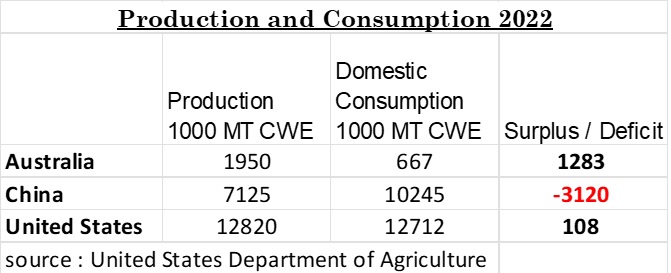
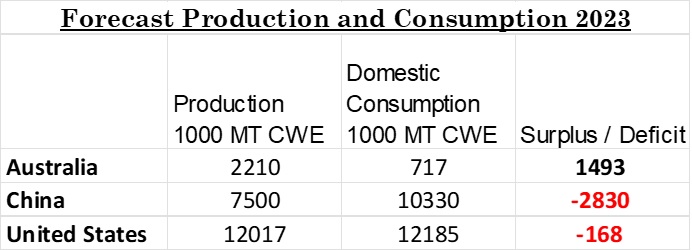
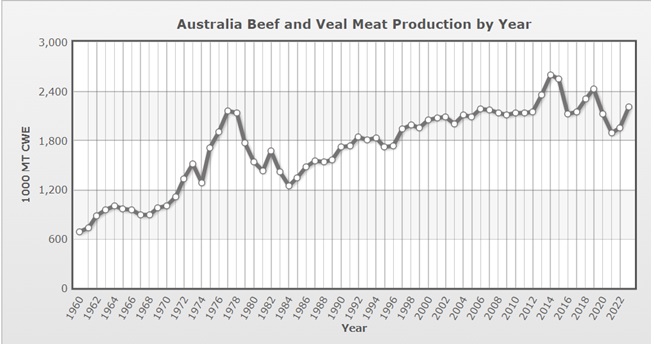
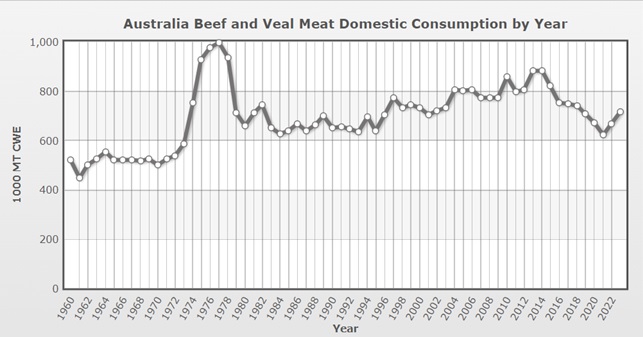
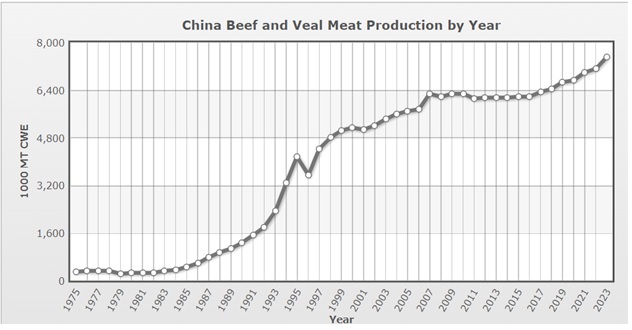
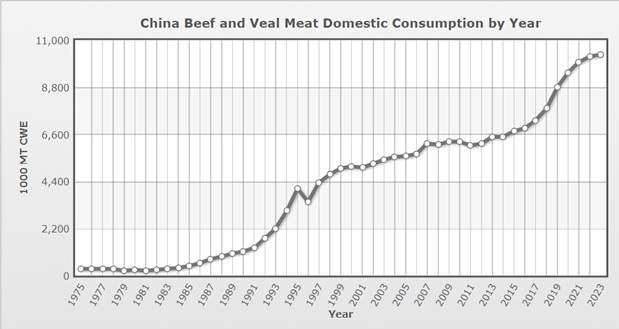
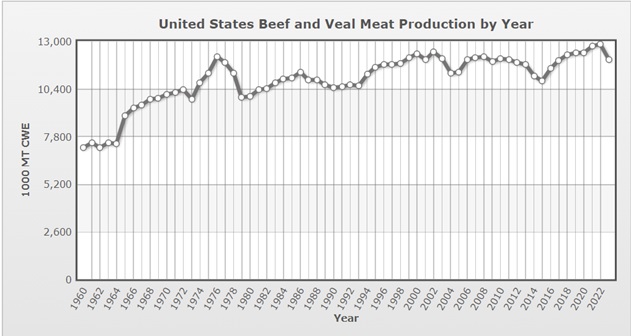
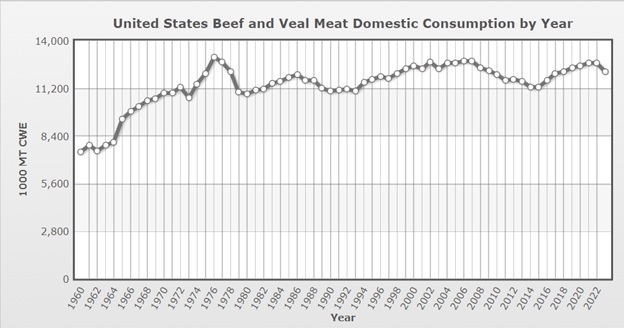
The largest feedlot unit in Russia is going to be built in Bryansk by Miratorg. The company plans to invest 4.6 billion roubles ($73.3 million) in its three feedlots in Bryansk and Oryol regions to 200 000 heads simultaneously.
The company announced in a press release that its biggest unit in Bryansk will have a total capacity of 80,000 cattle head.

"The new feedlot is a key element of a vertically integrated production chain: cattle fattened here are fed corn in order to increase the energy density of the diet and guarantee high carcass marbling. Also, the new feedlot will be specialised in feeding Wagyu cattle, which is characterised by super-high marbling of the meat. The design of the new feedlot was developed taking into account the special aspects of maintenance and finishing of this breed: a special ration, a longer period of stay on the feedlot and less mobility of animals. It is planned that Miratorg’s Wagyu beef will be supplied to the domestic market and for export," mentioned the company.
The total area of the feedlot is over 349 hectares, which includes 14 covered lines for cattle with slatted concrete floors, a storehouse for concentrated and loose feed and premixes, an administrative building, a garage, an animal treatment facility, a veterinary hospital, a water intake facility and more. For the design and construction of facilities, the company used the experience of world leaders of beef cattle breeding – the USA and Canada.
By now, the cattle herd owned by the company has exceeded 600,000 head and the plan is to grow it to 1 million by 2024.
